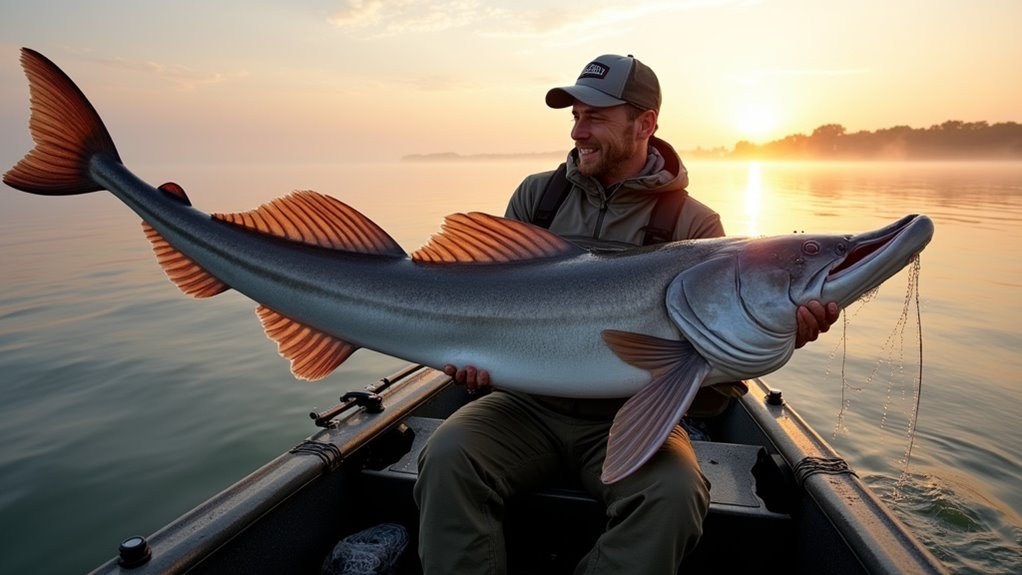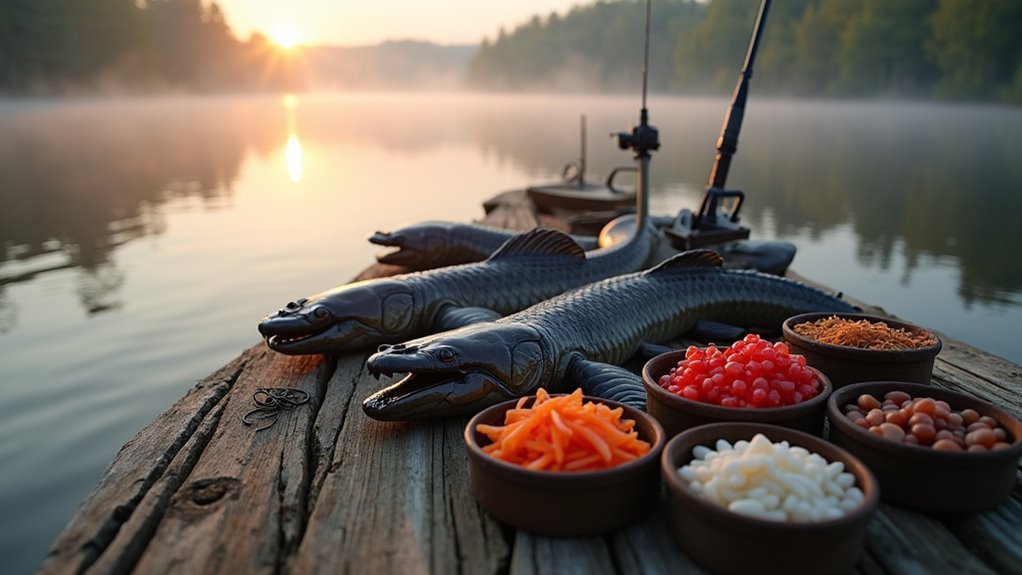Successful Midwest sturgeon fishing requires targeting specific locations like underwater structures and deep channels with rocky substrates. Trophy specimens often lurk outside heavily pressured areas. Timing matters greatly – spring spawning runs, summer deep holes (20-45 feet), and fall feeding frenzies offer prime opportunities. Use medium-heavy rods, high-capacity reels with 80+ pound test, and fresh bait like nightcrawlers or cut gizzard shad. Perhaps the most essential skill is mastering the subtle hook-set technique these hard-mouthed giants demand.
Finding Trophy Sturgeon in Great Lakes Waters

Where do the biggest sturgeon in the Great Lakes actually hide? Trophy lake sturgeon typically congregate in the northern regions of the basin, becoming scarcer as you venture south.
These prehistoric giants prefer deeper channels with rocky substrates and areas near river mouths where food is plentiful.
Lake sturgeon thrive in deep, rocky channels and nutrient-rich river mouths throughout the Great Lakes system.
I think the most successful anglers target shifting zones between shallow and deep water, especially during seasonal migrations.
Perhaps the best-kept secret is focusing on underwater structures that funnel these massive fish through predictable pathways.
The biggest specimens, sometimes exceeding 6 feet and weighing several hundred pounds, often hold in unexpected pockets just outside of heavily fished areas.
Seasonal Patterns for Midwest River Success
Because sturgeon migration patterns follow predictable seasonal cycles, anglers who understand these movements gain a significant advantage on Midwest rivers.
Spring spawning runs in rivers like the Rainy and St. Croix typically begin when water temperatures reach 50-55°F, creating prime fishing opportunities.
Summer months shift sturgeon to deeper holes, particularly in the Missouri River, where targeting 20-45 foot depths near rock structures proves effective.
During fall, feeding activity intensifies before winter, making late October through November excellent for Mississippi River sturgeon.
Winter ice fishing can be surprisingly productive, especially in northern Minnesota waters where sturgeon congregate in predictable deep pools.
Perhaps the most overlooked season, yet often delivering memorable catches.
Essential Gear Setup for Monster Sturgeon
Understanding seasonal patterns helps anglers find sturgeon, but catching these prehistoric giants requires specialized equipment. These behemoths demand gear that can handle their immense power and size, particularly when targeting trophy lake sturgeon that might exceed 100 pounds.
Four essential gear components include:
- A 7’6″ medium-heavy rod capable of absorbing powerful runs
- High-capacity reels with strong drag systems (80+ pound test capacity)
- Heavy braided mainline with 100-pound mono leaders to prevent cuts
- Circle hooks (5/0-8/0) that increase hookup percentages
I think most anglers underestimate sturgeon strength until they’ve felt that first run.
Perhaps the most important piece isn’t even listed – patience while waiting for that subtle, often barely perceptible bite.
Bait Selection Strategies That Outperform the Competition

Successful sturgeon anglers know that bait selection often makes the difference between a memorable day on the water and going home empty-handed. While nightcrawlers are reliable for lake and shovelnose sturgeon, savvy anglers match their bait to local preferences.
| Bait Type | Best For | Presentation Tip |
|---|---|---|
| Nightcrawlers | All species | Thread multiple worms on hook |
| Gizzard shad | Lake sturgeon | Fresh cut chunks work best |
| Crawfish | River sturgeon | Remove claws before rigging |
Perhaps the most overlooked strategy is using regional favorites. In the Missouri River, fresh cut bait outperforms frozen every time. I’ve noticed that combining scents – maybe adding garlic to nightcrawlers – can trigger bites when standard offerings fail.
Advanced Hook-Setting Techniques for Hard-Mouthed Giants
Setting the hook properly on sturgeon requires specialized techniques that differ considerably from most other freshwater species. Their rubbery mouths and cartilaginous structure mean traditional hook sets often fail. I think patience is perhaps the most important element—wait for that definitive pull before reacting.
When a sturgeon bites, anglers should follow these proven methods:
- Feel for the “light tap” followed by steady pressure
- Execute a double hook-set with sweeping, upward motions
- Maintain consistent tension after setting the hook
- Avoid excessive force that might tear the hook free
Using circle hooks can help with self-hooking, though they’re not foolproof. The key is finding that balance between firmness and restraint.
Handling and Conservation Tips for Responsible Anglers
After hooking a sturgeon successfully, proper handling becomes the next challenge for anglers who wish to preserve these ancient fish for future generations.
The use of appropriate-sized nets is essential when landing these prehistoric giants, as smaller nets might damage their sensitive bodies.
When handling smaller sturgeon, gloves offer protection from their sharp scutes.
Perhaps the most effective calming technique is gently covering the fish’s head with a wet towel—this tends to settle them down considerably.
Always keep the fish in water as much as possible, I think, and report any tagged specimens to researchers.
Frequently Asked Questions
How Long Should I Fight a Sturgeon Before Attempting to Land It?
The fight with a noble sturgeon should last until the fish tires completely, allowing for safer handling. Typically 20-30 minutes for larger specimens, yielding when head-shaking subsides and they swim alongside the boat.
Can Sturgeon Be Caught Effectively From Shore, or Is a Boat Necessary?
Sturgeon can be caught effectively from shore, particularly in rivers like the Rainy and St. Croix. While boats provide access to deeper holes, shoreline fishing remains productive with proper bait and rigging techniques.
What Water Temperature Ranges Trigger the Best Sturgeon Feeding Activity?
Sturgeon feed most actively in water temperatures between 50-65°F in spring and fall, and 65-75°F in summer. Their metabolism slows considerably below 40°F and above 80°F, reducing feeding behavior.
Are Certain Moon Phases Better for Sturgeon Fishing Success?
While sturgeon activity has been linked to the new and full moon phases, scientific evidence connecting moon phases to sturgeon feeding behavior remains inconclusive. Local experience often trumps lunar calendar guidance.
How Can I Distinguish Between a Shovelnose Sturgeon and Endangered Pallid Sturgeon?
Darker, sandpaper-like skin versus pale, smooth skin. Flattened, shovel-shaped snout versus elongated, pointy snout. Inner barbels of shovelnose align with outer ones, while pallid sturgeon’s inner barbels are positioned behind the outer ones.